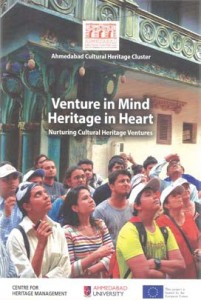Registered with the Registrar of Newspapers for India under R.N.I 53640/91
Vol. XXVI No. 14, November 1-15, 2016
Time for careers in heritage management
by A Special Correspondent


Among cities in India, Ahmadabad has always been different. It has often led the rest of the country in terms of political thought, commerce, science and the preservation and conservation of heritage. True, it does have its negatives, including strong inter-caste tensions and ghetto-isation on religious basis, but some of its positives are worth emulating. The Centre for Heritage Management (CHM) is one such initiative.
The Centre was established by the Ahmadabad Education Society which was founded in 1935. In 2009, the Society founded the Ahmadabad University which is self-financed and non-affiliated and CHM is now directly administered by the latter. The students of CHM are awarded degrees by Ahmadabad University at the end of their two-year programme.
Open to holders of a Bachelor’s Degree who have a demonstrated interest in heritage, the course, divided over four semesters, is an interesting mix of theory and practice. The first two semesters involve courses dealing with heritage, management (marketing, finance and human resources are some of the subjects dealt with here) and skills development. The third semester has flexible options for specialisation, including an exchange programme for study at a foreign university. The fourth semester is primarily project-based.
What is the kind of career that students who graduate from here can hope for? There are plenty of options. You could run a tourism bureau, apply for a job at a private museum in India (options are few) or, better still particularly abroad, take up the management of heritage collections belonging to private trusts, manage heritage properties with an eye on how to make them income-bearing, look at ways and means of conducting programmes for tourists and those interested in heritage experiences. For what it promises, the fee structure – Rs 2.3 lakh for the entire course – appears extremely reasonable.
As part of its various initiatives, CHM, in 2013 and 2016 collaborated with the European Union in hosting what it terms as the Cultural Heritage Management and Venture Lab in Ahmadabad. The initiative aimed to promote entrepreneurship in the heritage sector by bringing in multi-disciplinary stakeholders on to a single platform where they could debate and arrive at avenues of collaboration so that the city’s heritage could be preserved. The results have begun coming in and they are encouraging. All over the old walled city, heritage houses are being preserved, traditional arts and crafts are being revived, and an entire cultural fabric is being restored. It is, of course, still a long way to go before the benefits achieve critical mass, but what there is, is commendable.
Chennai could do well by learning from this initiative. For a city that can boast of many firsts and being a cultural capital, it is, strangely, hugely backward when it comes to preservation of visible reminders of heritage. Too often, such precincts, whether built or natural, are viewed simply in terms of real estate. There is simply no awareness of the potential that is waiting to be harnessed in heritage itself. Even the Government could use qualified professionals in heritage management.
Tamil Nadu has plenty of heritage locations that are crying out for basic amenities and some degree of marketing to make them popular. The State-controlled agencies have time and again proved failures in this, chiefly because they are hidebound and operate within their own knowledge levels. If they were to hire professional consultants to help make our heritage sites tourist friendly, there would be a marked rise in footfalls in these places. The economic benefit that would spill over would make the local community aware of the necessity to preserve its heritage. That by itself means the battle for conservation is won. If the Government cannot take up the initiative of setting up such a centre, would one of our industrial houses or major universities provide, like VIT or SRM or SASTRA consider it?

